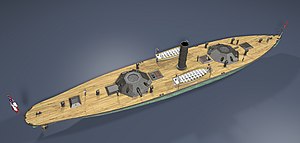CSS Wilmington
 A speculative computer model of CSS Wilmington had she been completed
| |
| History | |
|---|---|
| Name | Wilmington |
| Namesake | Wilmington, North Carolina |
| Builder | Berry Brothers shipyard, Wilmington, North Carolina |
| Laid down | 1864 |
| Fate | Burned, c. 22 February 1865 |
| General characteristics | |
| Type | Casemate ironclad |
| Length | 233 ft 4 in (71.1 m) ( o/a ) |
| Beam | 41 ft (12.5 m) |
| Draft | 9 ft 6 in (2.9 m) |
| Depth | 12 ft (3.7 m) |
| Installed power | 4 × boilers |
| Propulsion | 2 × propellers; 2 × geared direct-acting steam engines |
| Armament | 2 × guns |
CSS Wilmington was an unnamed casemate ironclad built for the Confederate States Navy during the American Civil War. The ship was never officially named and is referred to by historians by the name of the city in which she was built. Wilmington was still under construction during the February 1865 Battle of Wilmington and was destroyed to prevent her capture by Union troops after their victory.
Background and description

Wilmington was designed by the Chief Naval Constructor, John L. Porter, as a replacement for the rotten ironclad CSS North Carolina and the wrecked ironclad CSS Raleigh for the defenses of the Cape Fear River in North Carolina in 1864. Unlike those ships, Wilmington may have been designed to force engagements on the Union blockaders as her sleek lines and powerful propulsion machinery suggest something more than a defensive role.[1]
The ship had an
She was powered by a pair of high-pressure horizontal single-cylinder direct-acting steam engines that had a 28-inch (710 mm) bore and a 24-inch (610 mm) stroke. Each engine drove an 8-foot (2.4 m) propeller via 4-foot-6-inch (1.4 m) and 3-foot (0.9 m) gears, using steam provided by four tubular boilers. The propellers were connected by an idler shaft which prevented them from rotating at different speeds, which would have significantly inhibited the ship's maneuverability. All of the propulsion machinery was built by the Columbus Naval Iron Works in Columbus, Georgia, but had not been delivered before Wilmington was destroyed.[3]
The ship's
Construction and fate
Porter visited
Citations
Bibliography
- Bisbee, Saxon T. (2018). Engines of Rebellion: Confederate Ironclads and Steam Engineering in the American Civil War. Tuscaloosa, Alabama: University of Alabama Press. ISBN 978-0-81731-986-1.
- Canney, Donald L. (2015). The Confederate Steam Navy 1861–1865. Atglen, Pennsylvania: Schiffer Publishing. ISBN 978-0-7643-4824-2.
- Silverstone, Paul H. (2006). Civil War Navies 1855–1883. The U.S. Navy Warship Series. New York: Routledge. ISBN 0-415-97870-X.
Further reading
- ISBN 0-87249-454-3.
